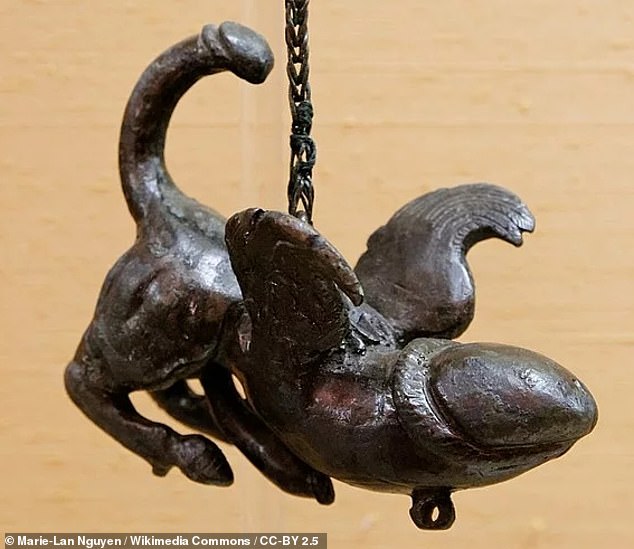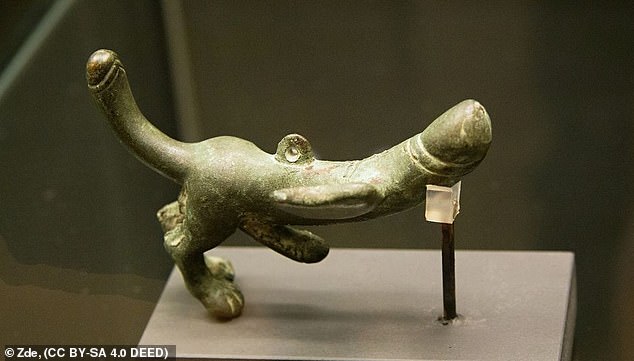‘Magical’ Roman wind chime is discovered in Serbia featuring a FLYING phallus that may have been used to ward off the evil eye
>
Archaeologists have discovered a very cheeky Roman wind chime featuring a magical flying penis.
Discovered in the Roman settlement of Viminacium in Serbia, scientists believe this strange object dates back to the 2nd century AD.
Wind chimes, or tinnabulum, would be proudly displayed outside a store or house in the affluent part of town.
While it would probably be seen as an erotic symbol today, the penis served a very different purpose at the time.
Experts say that the bells of this magic rod and its unusual appearance were designed to scare away the evil eye and “penetrate” malicious spirits.
Although damaged, archaeologists can still see the bells, stems and protruding rod in this magical wind chime
While the artifact was broken into a number of pieces, the bronze was well preserved, allowing its shape to be determined.
The mascot depicts a creature called a fascinum, a phallus with legs, wings, and multiple penises of its own.
Tintinnabulum also had four bells that would catch the wind and make a noise that was believed to drive away evil.
Archaeologists say this may have served as a form of doorbell, which would ring when someone entered.
Ilija Dankovic, an archaeologist at the Archaeological Institute in Belgrade who discovered the wind chime, told MailOnline there was nothing exciting or unusual about these symbols.
Instead, he says the penis was a “symbol of good luck and protection.”
“The penis was ubiquitous in the Roman world,” Dankovic told MailOnline.
“You had children carrying phallic amulets, they were painted on the walls of houses and shops, you even find them painted on Hadrian’s Wall.”
Phallic amulets, in particular, were also believed to ward off the evil eye, which was one of the main concerns of the Romans.

Since tintinapoleum was commonly found in centers of Roman culture such as Rome, Pompeii and Herculaneum, the discovery of one is an indication of a very Roman society

The fascinum, from which we get the word “fascination,” was a supernatural living phallus with legs, wings, and multiple penises of its own
The Romans believed that the evil eye could come from people you passed in the streets, from your enemies, or from more abstract forces like evil spirits.
“The penis was usually a weapon, because it was a penetrating object that could pierce the evil eye,” Dankovic explained.
“This thing was meant to attack and repel the evil eye. It protects the house from all kinds of entities and people who mean to do harm.”
What remains of the Roman city of Viminacium is located near the Serbian city of Kostolac, about 30 miles (50 km) east of the capital, Belgrade.
At its height, the city was home to 40,000 people including Roman legionaries and was the capital of Rome’s Upper Moesia province between the 1st and 5th centuries.

The Roman city of Viminacium was the capital of the Upper Moesia province and was once one of the largest settlements in the Balkans with a population of 40,000.
The city was sacked by Attila the Hun in 441 AD before it was rebuilt by Byzantine Emperor Justinian and eventually destroyed by the Slavs in 553 AD.
The wind chimes were discovered off the city’s main thoroughfare amid a pile of rubble and burnt beams.
Dankovich says it’s not yet clear whether this house burned down or if this is evidence of a larger fire that may have destroyed more of the city.
Experts excavating the site say the discovery is of particular importance for understanding the culture of Viminacium.
“Every piece of information is another piece of the mosaic that helps us understand everyday life,” Dankovich said.
“It’s the kind of thing you’d find in very Roman parts of the empire, and it’s important because it shows that Viminassium belonged to Roman cultural circles.”
Danković also says that Tintinnabulum was likely important from elsewhere in the Roman Empire, showing that Viminacium was home to wealthy social elites willing to pay a lot for such an item.
This is the second species of Tininabulum to be discovered at Viminacium, although the first remains in the hands of a private collector.
Previous excavations at Viminacium also uncovered fragile gold and silver scrolls buried with the dead that were believed to contain talismans.
These mysterious artifacts were written in Aramaic, and experts say they may have been used to summon good and evil spirits, as well as allowing the dead to perform magic in the afterlife.
(tags for translation) Daily Mail
